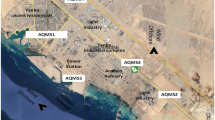Abstract
Delhi is one of the many megacities struggling with punishing levels of pollution from industrial, residential, and transportation sources. Over the years, pollution abatement in Delhi has become an important constituent of state policies. In the past one decade a lot of policies and regulations have been implemented which have had a noticeable effect on pollution levels. In this context, air quality models provide a powerful tool to study the impact of development plans on the expected air pollution levels and thus aid the regulating and planning authorities in decision-making process. In air quality modeling, emissions in the modeling domain at regular interval are one of the most important inputs. From the annual emission data of over a decade (1990–2000), emission inventory is prepared for the megacity Delhi. Four criteria pollutants namely, CO, SO2, PM, and NO x are considered and a gridded emission inventory over Delhi has been prepared taking into account land use pattern, population density, traffic density, industrial areas, etc. A top down approach is used for this purpose. Emission isopleths are drawn and annual emission patterns are discussed mainly for the years 1990, 1996 and 2000. Primary and secondary areas of emission hotspots are identified and emission variations discussed during the study period. Validation of estimated values is desired from the available data. There is a direct relationship of pollution levels and emission strength in a given area. Hence, an attempt has been made to validate the emission inventory for all criteria pollutants by analyzing emissions in various sampling zones with the ambient pollution levels. For validation purpose, the geographical region encompassing the study area (Delhi) has been divided into seven emission zones as per the air quality monitoring stations using Voronoi polygon concept. Dispersion modeling is also used for continuous elevated sources to have the contributing emissions at the ground level to facilitate validation. A good correlation between emission estimates and concentration has been found. Correlation coefficient of 0.82, 0.77, 0.58 and 0.68 for CO, SO2, PM and NO x respectively shows a reasonably satisfactory performance of the present estimates.
Similar content being viewed by others
References
CORINAIR Atmospheric Emission Inventory Guidebook (2001). 2001_3/en (EEA technical report n. 30) Third ed. Copenhagen: European Environment Agency. Retrieved from: http://reports.eea.eu.int/technical_report.
CSE (Centre for Science and Environment) (1996). Slow murder. A CSE publication. Centre for Science and Environment, 41, Tughlakabad Institutional Area, New Delhi, India. E-mail: cse@cseindia.org.
DSH (Delhi Statistical Handbook) (2000). Directorate of economics and statistics. New Delhi: Govt. of NCT of Delhi.
Du, Q., & Gunzburger, M. (2002). Grid generation and optimization based on centroidal Voronoi tessellations. Applied Mathematics and Computation, 133, 591–607.
EEA (European Environment Agency) (2000). COPERT III. Computer program to calculate emissions from road transport. Methodology and emission factors (version 2.1).
EEA (European Environment Agency) (2001). EEA Technical Report No. 49. Joint EMEP/ESD (Economic Survey of Delhi) (2001–2002). Planning Department Government of National Capital Territory of Delhi, 6th Level, B-Wing, Delhi Secretariat, I. P. Estate. New Delhi (India). URL: http://delhiplanning.nic.in/Economic%20Survey/Ecosur2001–02/Ecosur2001–02.htm.
ESD (Economic Survey of Delhi) (1999–2000). Planning Department Government of National Capital Territory of Delhi, 6th Level, B-Wing, Delhi Secretariat, I. P. Estate http://www2.toki.or.id/book/AlgDesignManual/BOOK/BOOK4/NODE187.HTM.
Gurjar, B. R., van Aardenne, J. A., Lelieveld, J., & Mohan, M. (2004). Emission estimates and trends (1990–2000) for megacity Delhi and implications. Atmospheric Environment, 38, 5663–5681.
Kuhlwein, J., Wickert, B., Trukenmuller, A., Theloke, J., & Friedrich, R. (2002). Emission-modelling in high spatial and temporal resolution and calculation of pollutant concentrations for comparisons with measured concentrations. Atmospheric Environment, 36, S7–S18.
MCI (Ministry of Commerce and Industry) (2001). Handbook of industrial policy and statistics 2001. Office of the Economic advisor, Ministry of Commerce and Industry, Govt. of India, New Delhi. URL: http://eaindustry.nic.in/handout.htm.
Ministry of Transport website: http://transport.delhigovt.nic.in/default.html.
Mohan, M., & Dube, M. (1998). Ambient air quality assessment of sulphur dioxide over Delhi. Indian Journal of Environmental Protection, 720–728. August.
Monforti, F., & Pederzoli, A. (2005). THOSCANE: A tool to detail CORINAIR emission inventories. Environmental Modelling & Software, 20(5), 505–508. New Delhi. URL: http://delhiplanning.nic.in/Economic%20Survey/Economic%20Survey%201999–2000.htm
Okabe, A., Boots, B., & Sugihara, K. (1992). Spatial tesselations concepts and applications of Voronoi diagrams. New York: Wiley.
Orthofer, R., & Winiwarter, W. (1998). Spatial and temporal disaggregation of emission inventories. In H. Power & J. M. Baldasano (Eds.), Air pollution emissions inventory. In J. W. S. Longhurst & H. Power (Eds.), Advances in Air Pollution (pp. 51–70), vol. 3. Southampton: Computational Mechanics Publications.
Ritter, M., Ohr, B., & Gugele, B. (1999). Luftschadstoff-trends in Osterreich 1980–1998, BE-165. Vienna: Umweltbundesamt.
Sturm, P. J., Blank, P., Bohler, T., Lopes, M., Mensink, C., Volta, M., et al. (2000). In P. M. Borrell & P. Borrell (Eds.), Proceedings of the EUROTRAC Symposium ’98 vol. 2 (pp. 708–709). Southampton: WIT Press.
TERI (The Energy and Resources Institute) (1997). Environmental aspects of energy use in large Indian metropolises (p. 207). New Delhi: Tata Energy Research Institute. [TERI Project Report No. 94EM53]. Summary and Conclusions. URL: http://www.teriin.org/reports/rep06/rep0602.htm.
Xia, L., & Shao, Y. (2005). Modelling of traffic flow and air pollution emission with application to Hong Kong Island. Environmental Modelling & Software, 20, 1175–1188.
Author information
Authors and Affiliations
Corresponding author
Rights and permissions
About this article
Cite this article
Mohan, M., Dagar, L. & Gurjar, B.R. Preparation and Validation of Gridded Emission Inventory of Criteria Air Pollutants and Identification of Emission Hotspots for Megacity Delhi. Environ Monit Assess 130, 323–339 (2007). https://doi.org/10.1007/s10661-006-9400-9
Received:
Accepted:
Published:
Issue Date:
DOI: https://doi.org/10.1007/s10661-006-9400-9




